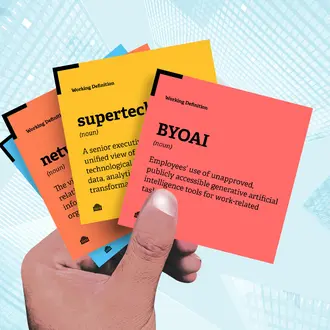Credit: The Boston Headshot
In 2000, Year Up CEO Gerald Chertavian founded the Boston-based job training nonprofit to create economic opportunities for young adults living in poverty. The organization teaches technical and business skills that will allow them to compete for millions of unfilled jobs in corporate America.
Year Up is geared to people 18 and 24 years old with a high-school diploma or equivalent. Students enrolled in the 12-month program receive training for high-demand jobs in finance and information technology and are connected to prospective employers through corporate internships with more than 250 companies, including Bank of America, Microsoft, and General Electric. Those students also receive a small stipend to offset lost wages while in the program, college course credit and counseling. Year Up has about 4,000 students enrolled annually.
During an Oct. 30 Innovative Leadership Series event at MIT Sloan, Chertavian detailed a path to leadership in social entrepreneurship.
Get close to the people you serve
Chertavian got the idea for Year Up in the mid-1980s, while he was a Big Brother to a 10-year-old boy in one New York City’s most crime-riddled neighborhoods. Chertavian saw through this close relationship with the boy and his family how race, money, and educational opportunity can do more to determine career options than ability.
That experience not only inspired Chertavian to create Year Up, but it also conveyed the lesson that social entrepreneurs can only know the people they serve by getting close to the way they live.
“Proximity matters if you want to be of service,” Chertavian said.
He recalled how a Year Up board member shared a chicken wing dinner with a student who spilled a wing on his shirt and then panicked. It was the boy’s only shirt, and he worried there wasn’t time to go to the laundromat before work the next day. The board member didn’t have to deal with having just one good shirt in his wardrobe, but it was a hurdle this student had to clear every day to be successful.
Don’t write off a nonprofit sector career
Chertavian cashed out of the technology company he co-founded before launching Year Up. However, he said waiting for financial security is no longer a prerequisite for becoming a social entrepreneur. The difference in pay for some nonprofit and private sector jobs has narrowed greatly in recent years, he said. Not only that, the public sector and some nonprofits are offering debt relief to employees. Chertavian said he was never truly happy with the direction of his career until he started Year Up, and he advised MIT Sloan students to follow their hearts.
“Do what makes you happy and not what you think other people want you to do,” Chertavian said.
Growth does not equal impact
Chertavian stressed money is not the only way to gauge success. Corporations are defined by their income growth each year, while nonprofits are measured by their impact on public policy.
“The social sector is so exciting because it's not just about growing a company, it's actually about changing the world,” Chertavian said. “A lot of folks here sit down every day and get up and think ‘How am I going to change the world?’ And you should, because you're at MIT.”



